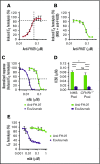Potentiation of complement regulator factor H protects human endothelial cells from complement attack in aHUS sera
- PMID: 30804016
- PMCID: PMC6391659
- DOI: 10.1182/bloodadvances.2018025692
Potentiation of complement regulator factor H protects human endothelial cells from complement attack in aHUS sera
Abstract
Mutations in the gene encoding for complement regulator factor H (FH) severely disrupt its normal function to protect human cells from unwanted complement activation, resulting in diseases such as atypical hemolytic uremic syndrome (aHUS). aHUS presents with severe hemolytic anemia, thrombocytopenia, and renal disease, leading to end-stage renal failure. Treatment of severe complement-mediated disease, such as aHUS, by inhibiting the terminal complement pathway, has proven to be successful but at the same time fails to preserve the protective role of complement against pathogens. To improve complement regulation on human cells without interfering with antimicrobial activity, we identified an anti-FH monoclonal antibody (mAb) that induced increased FH-mediated protection of primary human endothelial cells from complement, while preserving the complement-mediated killing of bacteria. Moreover, this FH-activating mAb restored complement regulation in sera from aHUS patients carrying various heterozygous mutations in FH known to impair FH function and dysregulate complement activation. Our data suggest that FH normally circulates in a less active conformation and can become more active, allowing enhanced complement regulation on human cells. Antibody-mediated potentiation of FH may serve as a highly effective approach to inhibit unwanted complement activation on human cells in a wide range of hematological diseases while preserving the protective role of complement against pathogens.
© 2019 by The American Society of Hematology.
Conflict of interest statement
Conflict-of-interest disclosure: R.B.P., M.C.B., T.W.K., and D.W. are coinventors of a patent (PCT/NL2015/050584) describing the potentiation of FH with mAbs and therapeutic uses thereof, which is licensed to Gemini Therapeutics, which provided partial financial support for this study. P.S.-C. has received speaking fees from Alexion Pharmaceuticals. The remaining authors declare no competing financial interests.
Figures







Similar articles
-
Unraveling the Effect of a Potentiating Anti-Factor H Antibody on Atypical Hemolytic Uremic Syndrome-Associated Factor H Variants.J Immunol. 2020 Oct 1;205(7):1778-1786. doi: 10.4049/jimmunol.2000368. Epub 2020 Aug 26. J Immunol. 2020. PMID: 32848031
-
Disturbed sialic acid recognition on endothelial cells and platelets in complement attack causes atypical hemolytic uremic syndrome.Blood. 2016 Jun 2;127(22):2701-10. doi: 10.1182/blood-2015-11-680009. Epub 2016 Mar 22. Blood. 2016. PMID: 27006390
-
Differential contribution of C5aR and C5b-9 pathways to renal thrombic microangiopathy and macrovascular thrombosis in mice carrying an atypical hemolytic syndrome-related factor H mutation.Kidney Int. 2019 Jul;96(1):67-79. doi: 10.1016/j.kint.2019.01.009. Epub 2019 Feb 27. Kidney Int. 2019. PMID: 30910380 Free PMC article.
-
Complement activation in diseases presenting with thrombotic microangiopathy.Eur J Intern Med. 2013 Sep;24(6):496-502. doi: 10.1016/j.ejim.2013.05.009. Epub 2013 Jun 4. Eur J Intern Med. 2013. PMID: 23743117 Review.
-
Anti-complement-factor H-associated glomerulopathies.Nat Rev Nephrol. 2016 Sep;12(9):563-78. doi: 10.1038/nrneph.2016.99. Epub 2016 Jul 25. Nat Rev Nephrol. 2016. PMID: 27452363 Review.
Cited by
-
Halting targeted and collateral damage to red blood cells by the complement system.Semin Immunopathol. 2021 Dec;43(6):799-816. doi: 10.1007/s00281-021-00859-8. Epub 2021 Jun 30. Semin Immunopathol. 2021. PMID: 34191092 Free PMC article. Review.
-
Tuning the Functionality by Splicing: Factor H and Its Alternative Splice Variant FHL-1 Share a Gene but Not All Functions.Front Immunol. 2020 Oct 15;11:596415. doi: 10.3389/fimmu.2020.596415. eCollection 2020. Front Immunol. 2020. PMID: 33178228 Free PMC article. Review.
-
Common Haplotypes within the Chromosome 1q31.3 Region Determine Systemic Concentrations of the Entire Complement Factor H Protein Family.J Innate Immun. 2025;17(1):244-261. doi: 10.1159/000545342. Epub 2025 Mar 26. J Innate Immun. 2025. PMID: 40139172 Free PMC article.
-
The contribution of the alternative pathway in complement activation on cell surfaces depends on the strength of classical pathway initiation.Clin Transl Immunology. 2023 Jan 27;12(1):e1436. doi: 10.1002/cti2.1436. eCollection 2023. Clin Transl Immunology. 2023. PMID: 36721662 Free PMC article.
-
The complement system in human pregnancy and preeclampsia.Front Immunol. 2025 Aug 19;16:1617140. doi: 10.3389/fimmu.2025.1617140. eCollection 2025. Front Immunol. 2025. PMID: 40904461 Free PMC article. Review.
References
-
- DiScipio RG. Ultrastructures and interactions of complement factors H and I. J Immunol. 1992;149(8):2592-2599. - PubMed
-
- Aslam M, Perkins SJ. Folded-back solution structure of monomeric factor H of human complement by synchrotron X-ray and neutron scattering, analytical ultracentrifugation and constrained molecular modelling. J Mol Biol. 2001;309(5):1117-1138. - PubMed
-
- Okemefuna AI, Nan R, Gor J, Perkins SJ. Electrostatic interactions contribute to the folded-back conformation of wild type human factor H. J Mol Biol. 2009;391(1):98-118. - PubMed
-
- Okemefuna AI, Gilbert HE, Griggs KM, Ormsby RJ, Gordon DL, Perkins SJ. The regulatory SCR-1/5 and cell surface-binding SCR-16/20 fragments of factor H reveal partially folded-back solution structures and different self-associative properties. J Mol Biol. 2008;375(1):80-101. - PubMed
Publication types
MeSH terms
Substances
LinkOut - more resources
Full Text Sources
Other Literature Sources
Molecular Biology Databases
Miscellaneous

